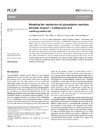Please use this identifier to cite or link to this item:
https://accedacris.ulpgc.es/handle/10553/74868
| Title: | Modeling the mechanism of glycosylation reactions between ethanol, 1,2-ethanediol and methoxymethanol | Authors: | Azofra Mesa, Luis Miguel Alkorta, Ibon Toro-Labbé, Alejandro Elguero, José |
UNESCO Clasification: | 2210 Química física | Issue Date: | 2013 | Journal: | Physical Chemistry Chemical Physics | Abstract: | The mechanism of the SN2 model glycosylation reaction between ethanol, 1,2-ethanediol and methoxymethanol has been studied theoretically at the B3LYP/6-311+G(d,p) computational level. Three different types of reactions have been explored: (i) the exchange of hydroxyl groups between these model systems; (ii) the basic catalysis reactions by combination of the substrates as glycosyl donors (neutral species) and acceptors (enolate species); and (iii) the effect on the reaction profile of an explicit H2O molecule in the reactions considered in (ii). The reaction force, the electronic chemical potential and the reaction electronic flux have been characterized for the reaction path in each case. Energy calculations show that methoxymethanol is the worst glycosyl donor model among the ones studied here, while 1,2-ethanediol is the best, having the lowest activation barrier of 74.7 kJ mol1 for the reaction between this one and the ethanolate as the glycosyl acceptor model. In general, the presence of direct interactions between the atoms involved in the penta-coordinated TS increases the activation energies of the processes. | URI: | https://accedacris.ulpgc.es/handle/10553/74868 | ISSN: | 1463-9076 | DOI: | 10.1039/c3cp51963e | Source: | Physical Chemistry Chemical Physics [ISSN 1463-9076], v. 15, p. 14026--14036 |
| Appears in Collections: | Artículos |
WEB OF SCIENCETM
Citations
7
checked on Jun 8, 2025
Page view(s)
55
checked on May 5, 2024
Download(s)
150
checked on May 5, 2024
Google ScholarTM
Check
Altmetric
Share
Export metadata
Items in accedaCRIS are protected by copyright, with all rights reserved, unless otherwise indicated.
